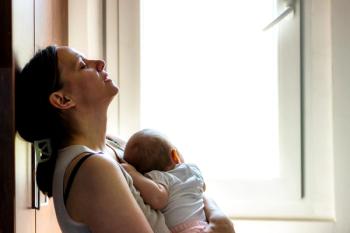
Burnout and Subfertility in Female Physicians: Examining the Bidirectional Relationship and Emphasizing the Need for Change
Key Takeaways
- Subfertility and burnout are interconnected, with stress affecting reproductive health and fertility challenges exacerbating emotional distress in women physicians.
- Delayed childbearing due to medical training increases subfertility risk, with nearly 25% of female physicians facing infertility.
In this Tales From the Clinic article, explore the hidden struggles of female physicians facing subfertility and burnout, and discover essential strategies for support and intervention.
TALES FROM THE CLINIC
-Series Editor Nidal Moukaddam, MD, PhD
In this installment of Tales From the Clinic: The Art of Psychiatry, we look at subfertility in women physicians. The toll of burnout, work-life imbalance, and poorly supportive settings contribute to a barely discussed, barely addressed epidemic. Proper personal and institutional interventions are needed, with a strong call to action to start discussing these issues in medical school and plan proactively as residency and attending-level work. Fertility preservation measures, such as egg-freezing, are still not part of the routine planning for most physicians, but can be an effective institutional path, displacing the burden and associated negative feelings from the individual, and bringing transparency to this issue.
Case Study
“Dr Doe,” a 38-year-old surgeon, presents with infertility after a year of unsuccessful attempts to conceive. Her demanding schedule, frequent overnight shifts, and chronic stress have led to emotional exhaustion and burnout, highlighting the link between professional stress and reproductive health. With each negative pregnancy test, she finds herself more and more frustrated and defeated.
Dr Doe delayed childbearing for her medical training, assuming she had time later. Fertility evaluation revealed diminished ovarian reserve, while her partner’s semen analysis was normal. She reports chronic fatigue and depersonalization from patients. Her 65-hour workweeks disrupt sleep and self-care, exacerbating stress-related infertility. She feels like a failure despite her successful career and happy marriage. She is under family pressure “to finally have a baby.” Her initial care plan included controlled ovulation induction with medications like clomiphene citrate (Clomid) and intrauterine insemination, with in vitro fertilization (IVF) as a backup plan. She ultimately started treatment for IVF, but the hormones made her moody and tearful. Scheduling ultrasounds and blood draws took a toll on her schedule, and colleagues commented she looked tired and somewhat irritable. She describes her worse moment, on a random Monday, crying the car and thinking “I cannot do this.” She abruptly cancelled a presentation she had agreed to for months.
Dr Doe took the Maslach Burnout Inventory (MBI), and high infertility-related distress was noted on the Fertility Quality of Life (FertiQoL) tool. Elevated cortisol levels indicated stress-induced hypothalamic dysfunction, potentially affecting ovulation. She sought mental health support, using
After 9 months, Dr Does’s well-being improved, her cycles normalized, and she conceived via IVF.
Discussion
Women's representation in medicine has grown exponentially in recent decades, with female physicians comprising nearly half of medical school graduates. This demographic shift brings new challenges, including the interplay between professional demands and personal aspirations, particularly the desire for childbearing. Many women physicians delay pregnancy to complete the extensive training required to establish themselves in their fields, often extending into their mid- to late-thirties. Such delays can heighten the risk of subfertility, defined as difficulty conceiving after 12 months of regular, unprotected intercourse (6 months for women over age 35).
According to a 2016 survey published in the Journal of Women's Health, nearly 25% of female physicians who attempt to conceive receive an infertility diagnosis.1 A more recent study, published in July 2021 in JAMA Surgery, involved 692 female surgeons and reported that 42% experienced a pregnancy loss.2 This exceeds the rate seen in the general population by more than 2-fold. Medical training is an extensive process; medical school, residency, and fellowship can span 10+ years, depending on specialty. The average age for female physicians to complete residency is 31, and the average age for female physicians to give birth is 32 vs 26 for nonphysicians.3 The rigorous demands of medical training and practice can negatively affect female physicians' overall health and, ultimately, impact their fertility. Such demands result in prolonged shifts,
As the pursuit of pregnancy becomes more complex, these women physicians also face high rates of burnout. Characterized by emotional exhaustion, depersonalization, and reduced personal accomplishment, burnout can stem from prolonged workplace stress and inadequate organizational support. Moreover, subfertility and burnout can create a self-reinforcing cycle: chronic stress and the attendant dysregulation of the hypothalamic-pituitary-adrenal (HPA) axis may impede reproductive functioning, while repeated fertility setbacks amplify emotional distress, exacerbate burnout, and undermine clinical performance. This article explores the relationship between burnout and subfertility, highlighting practical insights for psychiatrists and other mental health professionals involved in caring for women physicians.
The Current State of Research
Female physicians are forced to deal with unique challenges that often result in delays in pregnancy, longer hours, and experience higher job-related stress. Examples of such challenges include balancing work-life responsibilities with family expectations, limited opportunities for career advancement, and a higher risk of burnout due to the stress of managing societal perceptions about their role as a doctor and a woman. These are all factors that collectively contribute to subfertility risk.
Increasing evidence suggests that certain stress-related pathways, including heightened cortisol levels, may directly interfere with the neuroendocrine signaling required for ovulation and implantation.3 Furthermore, ongoing studies indicate that medical culture, marked by a reluctance to show vulnerability or take extended leave, may deter many from seeking timely fertility evaluations and treatments.5,6 Despite these recognized risk factors, large-scale longitudinal research examining the specific mechanisms linking physician burnout to subfertility remains limited. At present, institutional efforts aimed at mitigating burnout include more flexible scheduling, paid parental leave, and counseling services, but a comprehensive, evidence-based framework to protect and optimize fertility among female physicians is still evolving.7,8
Additionally, there is growing consensus that more research is needed to explore the full range of hormonal and biological processes affecting fertility in high-stress professions. While some efforts focus on stress hormone dysregulation, emerging lines of inquiry also investigate the interplay of reproductive hormones with work-related circadian disruptions. However, these studies are not yet sufficiently large or standardized to yield definitive guidelines. As a result, calls for expanded clinical trials and studies have gained traction, highlighting the urgent need to better understand and ultimately improve women physicians' reproductive health outcomes.8 Furthermore, as the number of women entering medicine continues to climb and the US birth rate declines, comprehensive research into subfertility among female physicians is increasingly critical to ensure their reproductive health needs are met and to sustain the future workforce.
The Convergence of Burnout and Subfertility
Burnout is increasingly recognized as a pervasive issue within the medical profession. Multiple factors contribute to its onset, such as excessive work hours, administrative burdens, moral distress, and the weight of academic and clinical responsibilities. Women in medicine often shoulder added pressures, including cultural and institutional norms that implicitly discourage extended time off for pregnancy, maternity leave, or self-care.9,10
Simultaneously, the age-related decline in fertility, often accelerated by stress, insufficient sleep, and other lifestyle factors, is more pronounced in populations that choose to delay childbearing.10,11 Women physicians may thus find themselves at the intersection of professional burnout and subfertility, each magnifying the other's impact. Chronic stress associated with burnout disrupts normal hormonal rhythms, which can negatively affect ovulation and implantation. For women actively trying to conceive, each unsuccessful cycle contributes to psychological strain and emotional depletion, further deepening burnout symptoms.
The psychosocial consequences of this convergence are considerable. Feelings of shame and guilt commonly emerge as these highly accomplished professionals wrestle with the notion that they can excel in medicine yet struggle to fulfill a personal wish of motherhood. Marital and partnership tensions may also intensify because of the rigid demands of fertility treatments, which require strict timing for medications and procedures and often clash with unpredictable physician work schedules.
Clinical Recognition and Assessment
Early identification of burnout and subfertility-related distress is crucial for interventions to be effective. Mental health providers, especially those specializing in reproductive psychiatry or working in high-stress medical environments, can benefit from systematically screening women physicians for both issues.
Burnout can be measured using established tools such as the MBI, which assesses emotional exhaustion, depersonalization, and personal accomplishment.12 Alternatively, shorter instruments or single-item scales may be employed for time-pressed professionals. Subfertility-related distress might be evaluated through direct questioning about fertility intentions and concerns, as well as validated measures such as the FertiQoL tool.12 Additional screening for common psychiatric comorbidities, including depression and anxiety, can be performed with standard measures.
Psychiatrists should also routinely inquire about the specific pressures that arise from balancing clinical duties, potential fertility treatments, and the emotional demands of repeatedly trying to conceive. A thorough assessment of a woman physician's work schedule, sleep patterns, social support, and marital or relationship dynamics can illuminate factors that exacerbate both burnout and subfertility.
Intervening in the Burnout-Subfertility Cycle
Addressing burnout and subfertility in tandem involves a multifaceted treatment approach that integrates psychotherapeutic interventions, psychopharmacological support when needed, lifestyle modifications, and broader institutional advocacy.
Psychotherapeutic interventions. CBT can help individuals recognize and reframe mental distortions that arise from chronic stress. For women physicians experiencing repeated fertility setbacks, CBT strategies may include coping techniques that mitigate the sense of personal failure surrounding fertility challenges. Mindfulness-based interventions and stress-reduction techniques such as yoga, meditation, or short relaxation exercises can also help regulate the physiological arousal linked to stress, potentially supporting healthier hormonal rhythms essential for reproduction.
Pharmacotherapy. In cases where mood or anxiety symptoms are severe, selective serotonin reuptake inhibitors or other appropriate psychiatric medications may be beneficial. Collaboration with reproductive endocrinologists is essential to ensure that any pharmacological regimen is compatible with fertility treatments or pregnancy. If insomnia is a prominent complaint, nonpharmacological options such as CBT should be considered before prescribing short-term sleep aids.
Lifestyle and self-care. Encouraging self-care is critical for mitigating burnout and improving fertility potential. This includes promoting adequate sleep, balanced nutrition, and moderate exercise. Although physician schedules are often demanding, minor adjustments like structured break times, mindfulness practices between patient visits, and protected weekends can reduce chronic stress levels. A short sabbatical or extended leave specifically for fertility treatments and psychological recovery may be warranted in more severe cases.
Relationship and couples therapy. Subfertility commonly places a strain on intimate relationships, intensified by the high-stress and unpredictable nature of a medical career. Couples therapy can facilitate open communication about treatment options, financial and emotional investments, and the day-to-day scheduling demands of fertility regimens. It can also help partners codevelop strategies to navigate fluctuating work hours or moral dilemmas, such as whether to pursue advanced treatments.
Institutional and Policy-Level Considerations
Though individual coping strategies are vital, large-scale solutions also require systemic and cultural changes within health care organizations. Institutional policies that allow flexible scheduling would ensure adequate coverage for fertility-related appointments and provide partial or complete insurance coverage for assisted reproductive technologies.9 This can significantly reduce stressors associated with subfertility.
Similarly, addressing burnout at the organizational level through improvements in workflow, reducing administrative burdens, and fostering a culture that encourages employees to seek mental health support can have a protective effect on women physicians' emotional well-being and reproductive health.13 Leadership training, peer support programs, and mentorship opportunities geared toward work-life integration help normalize discussions around fertility challenges and reduce the stigma surrounding burnout.14
Advocacy at the professional society level (such as the American Psychiatric Association and the American Medical Association) can further efforts to recognize subfertility as a critical aspect of physicians' health. These bodies can set standards that support reproductive needs, incorporate mental health screenings into routine physician evaluations, and champion research on the complex interaction between chronic stress, burnout, and fertility outcomes.
Concluding Thoughts
Burnout and subfertility form a cyclical and mutually reinforcing relationship that significantly affects women physicians. Chronic workplace stress and delayed childbearing can disrupt physiological pathways critical to fertility, while fertility difficulties magnify emotional distress and professional exhaustion. Psychiatrists and other mental health providers equipped with validated screening methods and evidence-based interventions are uniquely positioned to break this cycle. Addressing both burnout and subfertility demands an integrative approach that spans individual psychotherapy, practical self-care measures, couples counseling, pharmacological support, and systemic institutional reform.
By recognizing the reciprocal effects of burnout and subfertility and by advocating for family-friendly, mentally healthy work environments, health care systems can better retain skilled women physicians and protect their emotional and reproductive well-being. Future research should continue to clarify the specific mechanisms linking burnout with reproductive outcomes and identify practical, targeted interventions to support women at this critical juncture of personal and professional life. Ongoing and expanded research into how burnout-related neuroendocrine changes, shift work, and other stress factors specifically impair ovarian function could yield more targeted interventions. Expanding existing studies to include larger, more diverse cohorts of women physicians would clarify the scope of subfertility in this population and guide the creation of evidence-based policies and clinical guidelines.
Ms Hakam is a medical student at Texas A&M’s EnMed program, where she conducts research in nanomedicine drug delivery systems and postpartum mental health, and is actively engaged in mental health advocacy. Dr Moukaddam is a professor of psychiatry in the Department of Psychiatry at Baylor College of Medicine and the director of outpatient psychiatry at Harris Health System. She also serves on the Psychiatric Times Editorial Board.
References
1. Stentz NC, Griffith KA, Perkins E, et al.
2. Rangel EL, Castillo-Angeles M, Easter SR, et al.
3. Cusimano MC, Baxter NN, Sutradhar R, et al.
4. Karunyam BV, Abdul Karim AK, Naina Mohamed I, et al.
5. Reckhow JD, Ainsworth AJ, Holst KA, et al.
6. Pfennig CL, Wilson CA, Britt TW, et al.
7. Bakkensen JB, Smith KS, Cheung EO, et al.
8. Marshall AL, Arora VM, Salles A.
9. Lai K, Garvey EM, Velazco CS, et al.
10. Doxsey M, Patel K, Faschan K, Reyes L.
11. Győrffy Z, Dweik D, Girasek E.
12. Maslach C, Jackson SE, Leiter MP. Maslach Burnout Inventory Manual. 3rd edition. Consulting Psychologists Press; 1996.
13. Chesak SS, Cutshall S, Anderson A, et al.
14. Sheiner E, Sheiner EK, Potashnik G, et al.
Newsletter
Receive trusted psychiatric news, expert analysis, and clinical insights — subscribe today to support your practice and your patients.

















